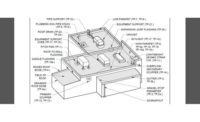Flashing:Flashing material should be the same mil thickness, color and type as the existing flashing.
Bonding adhesive:The bonding adhesive is produced with a nitrile PVC base and solvents such as toluol and methyl ethyl ketone (MEK). Water-based bonding adhesives are also available that use acrylic latex as a base material.
Splice Cleaner: Cleaner is required at splice areas where contaminants prohibit a proper weld of the membrane. The cleaner is produced of napthinic solvents.
Repair Procedures
The National Roofing Contractors Association (NRCA) and the Single Ply Roofing Industry (SPRI) approve the following repair procedures when installing a patch to return the membrane to a watertight condition:
1. To promote thorough adhesion of a patch, it is essential to begin preparing the surface by removing debris, contaminants and ballast from the area of the membrane or flashing to be repaired. The area prepared should extend beyond the perimeter of the patch to provide an ample-sized clean work area.
2. Scrub the repair area with a solution of detergent and water containing trisodium phosphate. Use warm water and a stiff-bristle brush to scrub the membrane.
3. Rinse thoroughly with clean water and allow the membrane to dry. A rubber-bladed squeegee and clean, absorbent, lint-free cloths may be used to facilitate drying.
4. If the existing membrane surface is excessively contaminated or degraded, carefully enlarge the hole (make round) to allow the insertion of the new patch material under the existing membrane so that welding of a patch may be accomplished to the unexposed, less degraded side of the existing membrane.
5. Cut a patch from a piece of new membrane material large enough to extend 4 inches beyond any part of the defect. Round all corners of the patch to limit peeling of square corners.
6. Round the ends of the defect in the existing membrane.
7. Wipe the area of the existing membrane to receive the patch and the underside of the patch material with a clean, absorbent, lint-free cloth dampened with a solvent such as MEK or acetone. Do not pour the solvent directly on the membrane. Wipe the area clean with the solvent-dampened cloth.
8. Allow the surface of the membrane and patch to air dry.
9. Weld the patch in place by using the three-step thermoplastic welding process: tack-weld, pre-weld and final-weld as described in the following:
- Tack-weld the patch to the existing membrane by using a hot-air welder to weld the membrane sufficiently to hold the patch in place taking care to not wrinkle the patch material.
- Pre-weld the patch by inserting the hot-air nozzle under the patch and forming a continuous pre-weld approximately 2 inches from the edge of the patch. This pre-weld will prevent heat leakage during the final welding and is achieved by following the welder nozzle closely with a rubber-faced hand roller to provide pressure to adhere the back of the weld area.
- Final-weld the outer 2 inches by concentrating the heat on the remaining unadhered outer portion of the patch until the membrane and patch have reached the welding temperature. The hot-air welder should be moved quickly enough to avoid scorching the membrane, yet slowly enough to achieve a complete weld. Immediately behind the welder, roll the material to be bonded with the rubber-faced hand roller, rolling parallel to the outside edge of the welder nozzle and pressing firmly to adhere and mate the materials.
11. Where patches are made with reinforced membrane material, seam seal the outer perimeter with seam sealant or caulking compatible with the membrane. This will prevent water from wicking through the exposed edge of the reinforcement.
12. If the ballast was removed, redistribute the ballast over the exposed area.


